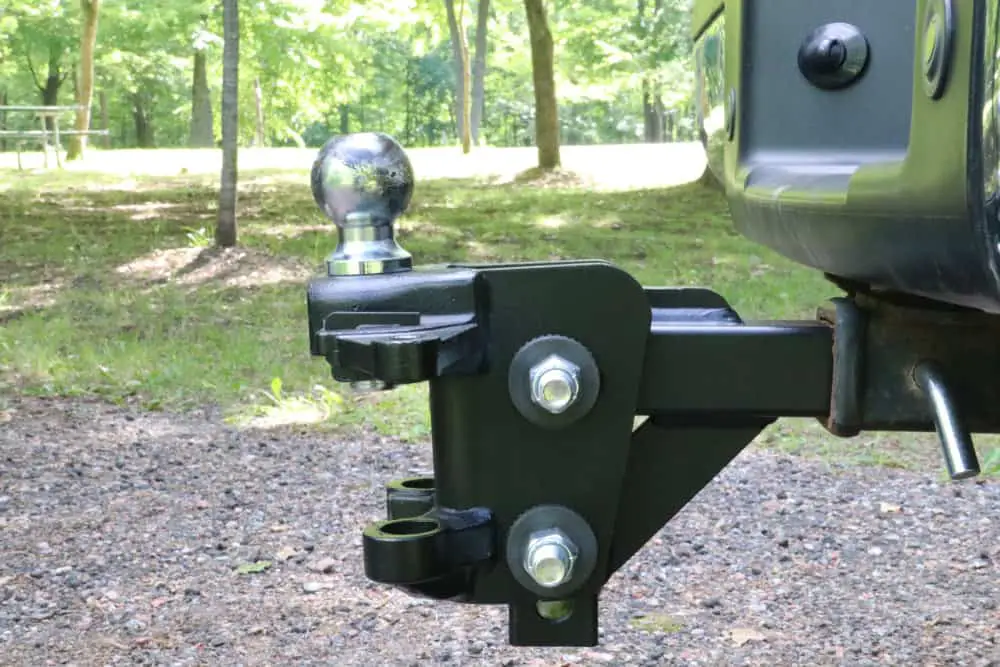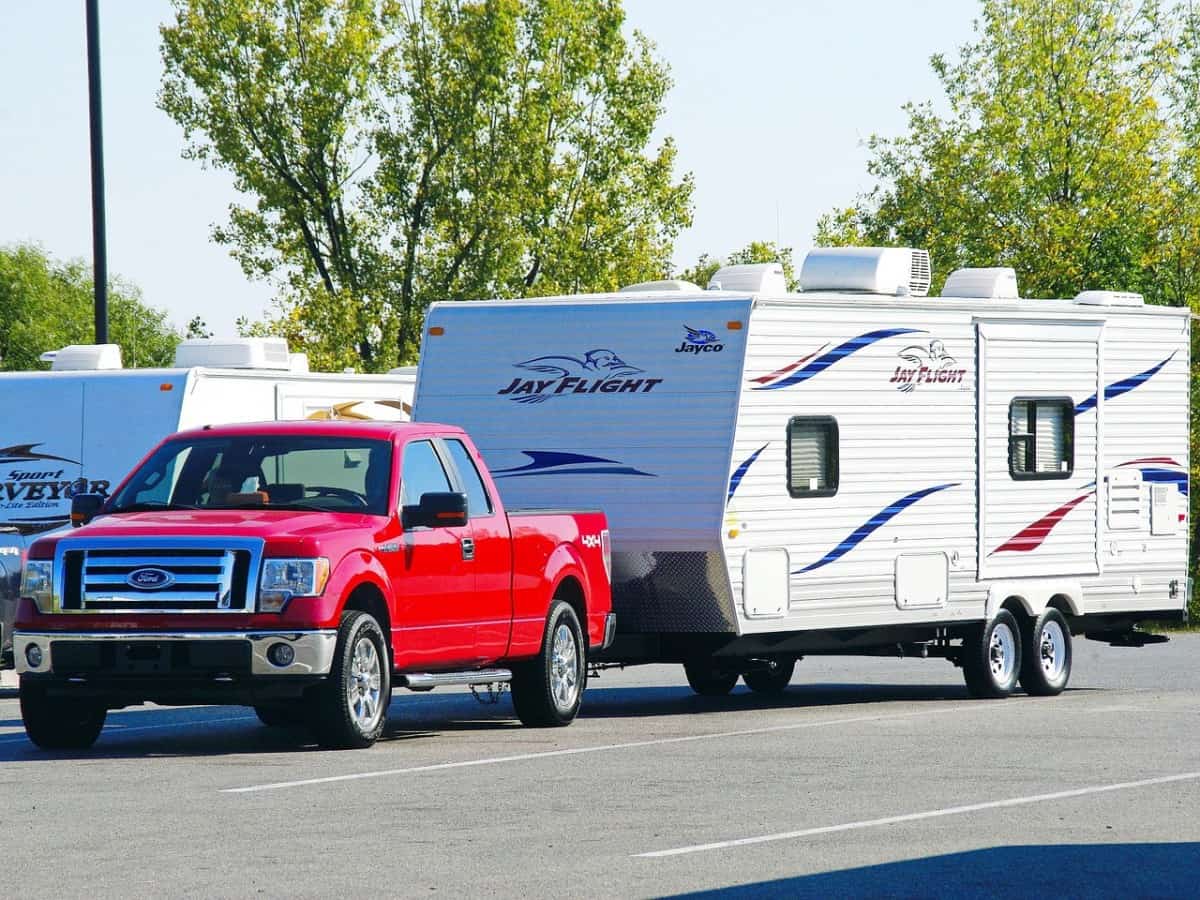Whether you’re a first-time buyer or a seasoned RVer who’s just upgraded to a larger rig, you might be wondering if you should also invest in a weight distribution hitch.
The answer is open to interpretation. While some people claim that they’re the best thing to happen to travel trailers since the invention of the indoor shower, they aren’t always necessary. Here’s how to tell whether you need one of these devices or not.
What Is A Weight Distribution Hitch?
These setups (sometimes called WDHs for short) are used to link the tow vehicle to the travel trailer in combination with the coupling. They’re designed to make the trailer easier to tow by distributing the load between the vehicle and the unit itself.
As a general rule, you only need a WDH if your trailer is exceptionally long or very heavy. Toy haulers, for example, often need the extra help, especially when they’re fully loaded with gear. If you’ve purchased an ultra-lite trailer and the load is well balanced, then there’s no need to invest in a WDH.
How To Tell If You Need A WDH
The National Association of Trailer Manufacturers (NATM) offers a list of guidelines that can fill you in on the proper vehicle-to-trailer weight ratios. When you’re towing a lighter camper, a ball mount usually does the trick. It’s even acceptable to haul a heavier RV using a ball mount, as long as the towing vehicle has a high enough rating.
Unfortunately, there’s no clear answer regarding weight limits for ball hitches vs. weight distribution hitches. To determine the right path, you’ll need to take a look at your trailer’s specs and perform a few measurements of your own.
Check the owner’s manuals for both your RV and your tow vehicle. If the rig you’ll be towing weighs nearly as much as the vehicle itself, then you’ll probably end up needing a WDH. If you’re still not sure, you can take the following steps to determine whether one is necessary.
Before loading the travel trailer with gear, water, and fuel, take measurements of its front and rear height. When the wheels are level, these numbers should be identical.
Then measure the wheel arches of the tow vehicle from the top middle of the wheel to any fixed point along the circumference.
Once you’ve hitched the trailer to the tow vehicle, check the wheel measurements again. If there’s a difference of more than three-quarters of an inch, then it’s a good idea to use a WDH. If the difference is any smaller than that, you can probably get along fine using a ball hitch.
Of course, things might chance once the rig is all loaded up and ready to go. Fortunately, this kind of load imbalance is usually easy to spot even if you haven’t taken any measurements.
When the front of the tow vehicle rises when you hitch up the travel trailer, or if the back half of the vehicle seems to dip toward the ground, try rearranging your gear. Make sure the heaviest objects are positioned over the main axle. If this doesn’t work, then a WDH is in order.
How To Choose A WDH

If you do decide to go the WDH route, you’ll want to pick the right one. Like most of the gear associated with travel trailers, one size doesn’t necessarily fit all. That means you’ll need to take more measurements before you’re ready to start shopping.
Take a look at the travel trailer’s specs to determine the hitch weight. This refers to the amount of pressure that’s placed on the hitch once the unit is attached to the tow vehicle.
Once you have this number in hand, you can look for a WDH that fits within that load range. Your next step is to choose one that’s compatible with your tow vehicle. Since these are generally used only with heavy-duty rigs, you can expect the setup to include a towbar tongue, torsion bars, retaining pins, and A-frame clamps. There may also be a levering tool thrown into the mix.
What To Expect When You’ve Installed the WDH
The WDH is designed to evenly distribute the load so that your vehicle won’t sag in the back and nose up in the front. Therefore, your goal is to have a travel trailer and a tow vehicle that are perfectly balanced from end to end.
To check your progress, step back and take a good look at the vehicle’s position. If you’ve set the hitch at the correct angle and used the right number of chain links, the setup should be level. You can also take your front and rear wheel arch measurements again to make sure they still match, although you probably won’t get the same numbers you did before you hitched up.
Potential Issues
As you can imagine, a WDH is under a great deal of pressure. Manufacturers recommend releasing the spring bars whenever you’re negotiating rough terrain in order to avoid damaging the system. However, because it’s a huge pain to stop and adjust the tension all the time, most drivers don’t bother with this step.
You should also be aware that many vehicle manufacturers advise against using a weight distribution hitch on their models. Land Rover, for example, claims that these systems interfere with their automatic leveling feature. Similarly, if a Kia vehicle is equipped with a custom towbar, they recommend that you skip the load leveling device.
If you decide to go ahead and install a WDH without the manufacturer’s approval, you could be in big trouble with your insurance company if you get into an accident. Always make sure that your towing vehicle is WDH approved before you decide to install one.
In Conclusion
If you decide to use a weight distribution hitch, read all the instructions and recommendations carefully. A WDH that’s improperly installed can lead to disappointment and even structural damage. We would recommend using one of these systems only if the sizes of your travel trailer and towing vehicle leave you with no other option.
Best of luck, and happy camping!
Check out our article on: Average Price Of A Travel Trailer Based On Size

